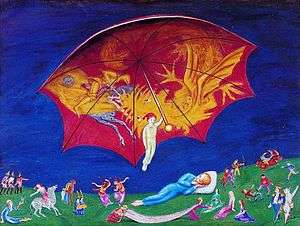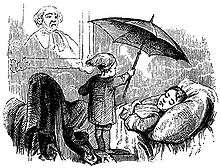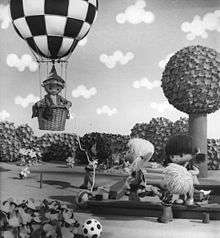Sandman
The Sandman is a mythical character in Western and Northern European folklore who puts people to sleep and encourages and inspires beautiful dreams by sprinkling magical sand onto their eyes.

Representation in traditional folklore
The Sandman is a traditional character in many children's stories and books. In Scandinavian folklore, he is said to sprinkle sand or dust on or into the eyes of children at night to bring on sleep and dreams.[1] The grit or "sleep" (rheum) in one's eyes upon waking is the supposed result of the Sandman's work the previous night.
Literature


E. T. A. Hoffmann (1776–1822) wrote a short story in 1816 titled Der Sandmann, which showed how sinister such a character could be made. According to the protagonist's nurse, he threw sand in the eyes of children who wouldn't sleep, with the result of those eyes falling out and being collected by the Sandman, who then takes the eyes to his nest on the Moon and uses them to feed his children. The protagonist of the story grows to associate this nightmarish creature with the genuinely sinister figure of his father's associate, Coppelius. In Romanian folklore there is a similar character, Moș Ene (Ene the Elder). Hoffmanns version of the sandman is also similar to the French Canadian character known as the bonhome Sept-heur (seven o’clock guy), who, in some versions, throws sand in children’s eyes to blind them so he may capture them. Contrarily to the sandman, his bag is the place where he traps children who don’t go to bed. [2]
Hans Christian Andersen's 1841 folk tale Ole Lukøje introduced the Sandman, named Ole Lukøje, by relating dreams he gave to a young boy in a week through his magical technique of sprinkling dust in the eyes of the children. "Ole" is a common Danish first name and "Lukøje" means "close eye". [3] Andersen wrote:
There is nobody in the world who knows so many stories as Ole-Luk-Oie, or who can relate them so nicely. In the evening, while the children are seated at the table or in their little chairs, he comes up the stairs very softly, for he walks in his socks, then he opens the doors without the slightest noise, and throws a small quantity of very fine dust in their eyes, just enough to prevent them from keeping them open, and so they do not see him. Then he creeps behind them, and blows softly upon their necks, till their heads begin to droop. But Ole-Luk-Oie does not wish to hurt them, for he is very fond of children, and only wants them to be quiet that he may relate to them pretty stories, and they never are quiet until they are in bed and asleep. As soon as they are asleep, Ole-Luk-Oie seats himself upon the bed. He is nicely dressed; his coat is made of silken fabric; it is impossible to say of what color, for it changes from green to red, and from red to blue as he turns from side to side. Under each arm he carries an umbrella; one of them, with pictures on the inside, he spreads over the good children, and then they dream the most beautiful stories the whole night. But the other umbrella has no pictures, and this he holds over the naughty children so that they sleep heavily, and wake in the morning without having dreams at all.
In Norway and Sweden, he is called John or Jon Blund and in Dutch and Afrikaans, a language spoken in southern Africa and related to Dutch, he is referred to as "Klaas Vaak".[4]
Television

The East German stop motion children's television programme Unser Sandmännchen (Our Little Sandman), based on Hans Christian Andersen's Ole Lukøje character and the story by E. T. A. Hoffmann, has been broadcast since 1959, along with a West German version which was discontinued after reunification. Santa Claus-franchised sandman appears as a legendary councilman.[5]
In the 1990s, Nilus the Sandman aired on Anglophone Canadian television.
Comics
Fantasy writer Neil Gaiman wrote a 75-part comic book series called The Sandman for Vertigo Comics. The original series ran from 1989 to 1996. It tells the story of Dream of the Endless, who rules over the world of dreams. He is an anthropomorphic personification of dreams known to various characters throughout the series as Morpheus, Oneiros, the Shaper of Form, Lord of the Dreaming, the Dream King, Dream-Sneak, the Cat of Dreams, Murphy, Kai'ckul, and Lord L'Zoril. He possesses three symbols of office: a helm, an amulet known as the Dreamstone, and a sand pouch.[6]
A comics adaption of the above mentioned German TV show Unser Sandmännchen has also been published. Most notably on the back pages of FF Dabei focusing on Pittiplatsch and his friends.
The manga, JoJo's Bizarre Adventure, also features a character called Sandman. This however is not the regular interpretation of Sandman, but a human who is running in the Steel Ball Run race.
Music
Songs based on the figure of the Sandman include the 1950s classic "Mr. Sandman",[7] Roy Orbison's "In Dreams" in which the singer is put to sleep by "a candy-colored clown they call the sandman" to dream of his lost love,[8] and Metallica's "Enter Sandman" whose lyrics "juxtapose childhood bedtime rituals and nightmarish imagery" and originally included a reference to crib death.[9][10] The Sandman also appears in the version of the lullaby "Morningtown Ride" recorded by The Seekers[11] and is mentioned briefly in the song “Headfirst Slide Into Cooperstown On A Bad Bet” by Fall Out Boy. British singer-songwriter Graham Nash makes a small reference to Sandman in the song "Sleep song" in the latest stanza:
"[...] Then I will wait till
The sandman
Has done with you [....]"
Finnish heavy metal band Lordi has the song "Blood Red Sandman".
The single "Mr. Sandman" was released by SYML in 2017.
See also
- Wee Willie Winkie – A Scottish nursery rhyme's personification of sleep
- Morpheus – Greek god of dreams
References
- Walsh, William Shepard. "Sandman", Heroes and Heroines of Fiction, Classical Mediæval, Legendary, J.B. Lippincott, 1915
- "Der Sandmann". germanstories.vcu.edu. Retrieved June 1, 2019.
- "Ole Lukoie". The Hans Christian Andersen Center. Retrieved June 1, 2019.
- "Jon Blund". Ny ABC. Retrieved June 1, 2019.
- Connolly, Kate (23 November 2009). "The Sandmannchen, Germany's cutest communist, turns 50". The Guardian.
- Neil Gaiman (27 April 2007). "Sandman, Master of Dreams". arschkrebs.de. Retrieved June 1, 2019.
- Betts, Stephen L. (9 September 2016). "Flashback: Parton, Ronstadt, Harris Share 'Those Memories of You'". Rolling Stone.
- Lehman, Peter (2003). Roy Orbison: The Invention of An Alternative Rock Masculinity, Temple University Press. ISBN 1-59213-037-2
- James Hetfield. When Metallica Ruled the World (TV Documentary). VH1. Archived from the original on January 30, 2016. Retrieved August 20, 2016.
Extras – "James On Writing "Enter Sandman" Lyrics, 2004; When Ruled the World
- Grierson, Tim (2006). "The Greatest Songs Ever! Enter Sandman". Blender. Archived from the original on November 1, 2007. Retrieved September 10, 2007.
- Reynolds, Malvina. "Morningtown Ride: Steyn's Song of the Week". SteynOnline.
Bibliography
- Andersen, Hans Christian. Fairy Tales of Hans Christian Andersen. Retrieved October 20, 2010.
- Tatar, Maria (2003). Hard Facts of the Grimms' Fairy Tales. Princeton, NJ: Princeton University Press. ISBN 978-0-691-01487-6.
- Hoffman, E.T.A. (1817). "Der Sandmann". Die Nachtstücke.
- Wm. G. Thilgen Jr. (2013) The Sand Man (Lulu Press, Inc) ISBN 9781304298874
External links
